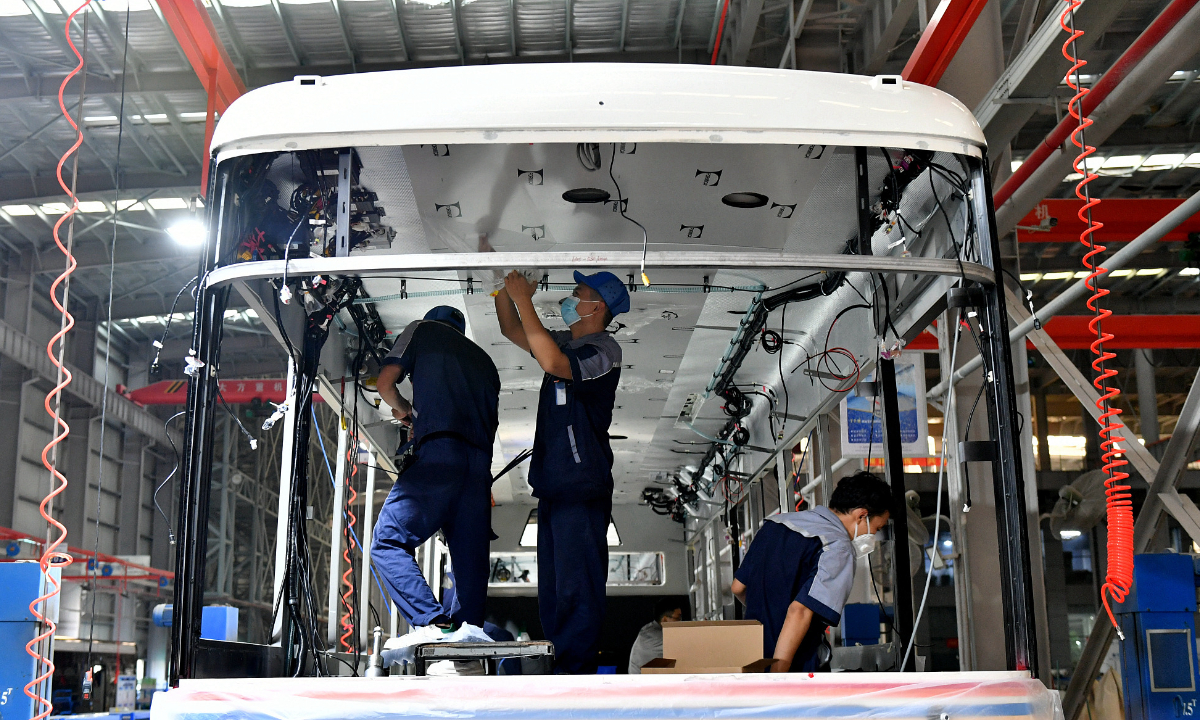Pulse on China's Economy: Decline of China’s industrial profits narrows further in 2023, underscoring resilience and recovery

Photo:VCG
Profits of China's major industrial enterprises fell 2.3 percent in 2023, continuing a month-on-month narrowing that began in March, an ongoing recovery that underscores the resilience of the Chinese economy, experts said.
In 2023, the profits of industrial companies whose annual main business revenue exceeded 20 million yuan ($2.82 million) stood at 7.69 trillion yuan, a year-on-year decline of 2.3 percent, narrowing by 2.1 percentage points from the first 11 months of last year, the National Bureau of Statistics (NBS) released on Saturday.
State-owned enterprises achieved total profits of 2.26 trillion yuan in 2023, down 3.4 percent year-on-year, while private enterprises had total profits of 2.34 trillion yuan, up 2 percent, NBS data showed.
With domestic demand improving gradually and industrial production picking up steadily, the profitability of large-scale industrial enterprises has continued to recover, further consolidating the foundation for high-quality development of the industrial economy, NBS statistician Yu Weining said in a statement on Saturday.
While the total profits of major industrial enterprises declined amid the multiple challenges at home and abroad, the narrowing trend has sent a positive signal that the Chinese economy is gradually overcoming various difficulties and stabilizing on an improving trend, Zhu Keli, executive director of China Institute of New Economy, told the Global Times on Saturday.
In terms of the moving trend of industrial profits throughout the year 2023, major industrial enterprises' profits saw a sharp narrowing of decline, given the year-on-year decrease of 22.9 percent in January-February, Yu said.
By quarter, the profit of industrial enterprises in the first quarter of 2023 fell by 21.4 percent year-on-year, with a 12.7 percent fall in the second quarter, before recording a 7.7 percent gain in the third quarter and a 16.2 percent increase in the fourth.
In December, profits of industrial enterprises rose by 16.8 percent year-on-year, growing for a fifth consecutive month, according to the NBS.
Overall, more than 60 percent of industries recorded profit gains in 2023. With the deepening industrial chain optimization and upgrading, the efficiency of the equipment manufacturing industry continues to improve, further strengthening its supporting role for the profit recovery of industrial enterprises, Yu said.
Specifically, due to the rapid rise in shipbuilding orders and the record high automobile production, the transport equipment industry saw profits jump by 22 percent year-on-year, while profits of the automobile industry increased 5.9 percent.
Against the backdrop of complex global economic changes, the recovering industrial profits reflected the tenacious resilience and innovation vitality of Chinese industries, Zhu noted.
Chinese industrial enterprises not only pay attention to short-term benefits, but also focus on the long-term development, constantly enhancing their core competitiveness and market adaptability by strengthening technological innovation and improving added value of products. Those efforts are gradually being translated into concrete economic benefits, offering a strong support for the recovery of industrial profits, according to Zhu.
"Industrial enterprises' performance has pointed to an overall trend that the Chinese economy is undergoing a continuous improvement," Xi Junyang, a professor at the Shanghai University of Finance and Economics, told the Global Times on Saturday.
With the continued policy support, the improvement in the operating conditions across the industrial sector is expected to continue in 2024, Xi said.
Despite facing multiple challenges, China's manufacturing industry has shown strong resilience in recent years, according to a report released on Saturday by the China Finance 40 Forum -- a Chinese think tank specializes on issues of economic and financial policy.
The report said that the growth rate of China's manufacturing sector investment has continued to be higher than the growth rate of the total capital investment and the GDP growth rate since 2020.
Meanwhile, the proportion of investment by private enterprises has further increased, and the manufacturing investment has been concentrating in industries such as electrical equipment, telecommunication and computing information.
The upgrading trajectory of China's manufacturing industry is consistent with the experience of high-income countries, said Zhang Bin, a senior CF40 researcher and deputy director of the Chinese Academy of Social Sciences' Institute of World Economics and Politics.
A modern service industry is a necessary condition for the upgrade of the manufacturing industry as it is difficult to see the sustainability of manufacturing investment higher than a society's fixed asset investment, Zhang said.



